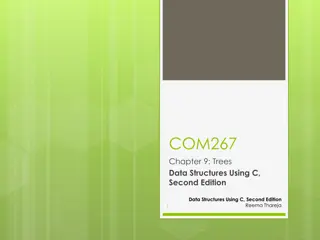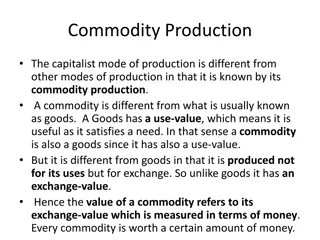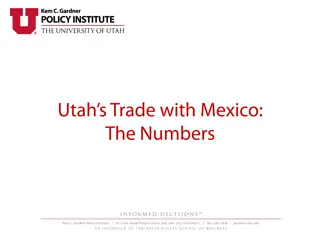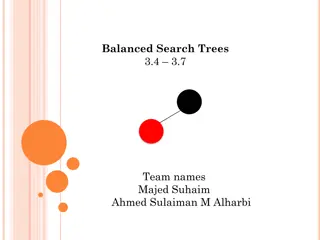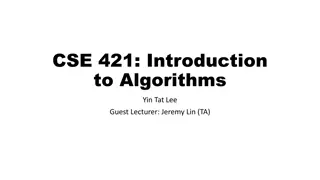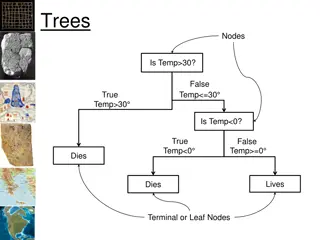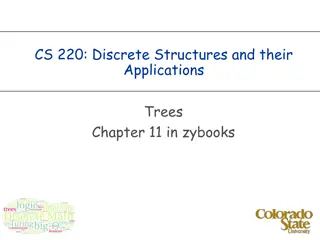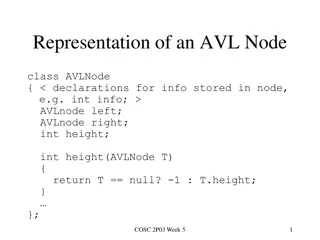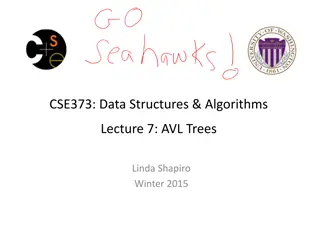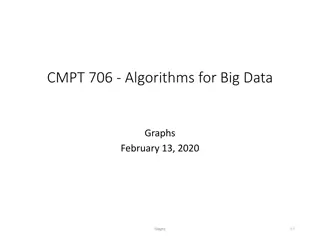Streamlined Forecasting for Future USDA Foods Utilization
Cathy Sparks, National Commodity Director, discusses the importance of communication in the forecasting process for USDA foods. Tools like the ProcessorLink calculator and K12 On Target planner help processors and distributors estimate quantities needed for production. Commodity Planning Made Easy s
7 views • 9 slides
Exploring Trees Data Structures Using C - Second Edition
Learn about trees data structures in the context of programming using the C language. This comprehensive guide covers topics such as types of trees, tree creation, traversal, basic terminologies, and different tree structures like binary trees and binary search trees. Dive into the world of trees da
4 views • 54 slides
Spring 2022 Commodity Update: Energy, Labour, and Market Insights
The Spring 2022 Commodity Update provides an overview of the current market conditions including energy and fuel price challenges, labor shortages in the UK food sector, and the impact on supply chains. Rising energy costs, particularly gas, and labor scarcity due to Brexit and Covid-19 are signific
3 views • 40 slides
Innovative CPC Futures Contract Program for Agribusiness Sustainability
The Commodity Plus Carbon (CPC) Futures Contract Program integrates agricultural commodity prices with carbon valuation to incentivize good agricultural practices and reduce carbon footprint. By combining ag commodity prices with carbon reductions, CPC contracts offer hedging opportunities and incen
2 views • 8 slides
Tips for Selecting Commodity on Non-Catalog Requisitions
When creating a non-catalog request, choosing the right commodity is crucial. This guide provides tips on selecting the appropriate commodity to streamline the procure-to-pay process effectively.
3 views • 5 slides
Commodity Production and Labor in Capitalist Mode
The capitalist mode of production is characterized by commodity production, where goods are produced not for their use but for exchange. The value of a commodity is determined by its exchange value, measured in money, which is influenced by the quantity of labor involved in its production. Labor, be
9 views • 8 slides
Analysis of Global Commodity Export Dependence Trends 2013-2017
The analysis includes data from the State of Commodity Dependence 2019 PDF, focusing on the degree of commodity export dependence of countries worldwide from 2013 to 2017. It examines specific countries falling into different percentage categories and explores the factors contributing to their posit
5 views • 11 slides
Utah's Commodity Trade with Mexico: Insights and Impacts
Explore Utah's total commodity exports and imports with Mexico, top commodity exports, economic impacts of reduced trade, and more through insightful visuals depicting trade dynamics in 2016. Gain valuable insights into Utah's trade relationships and economic implications of changes in commodity tra
3 views • 7 slides
International Merchandise Trade Statistics Workshop Overview
Presentation by Nilima Lal at the International Merchandise Trade Statistics Workshop in Nadi, Fiji focusing on the compilation, analysis, and dissemination of trade data. The workshop emphasizes the importance of relevant information on imported and exported goods, development partners collaboratin
4 views • 10 slides
Improving the Reliability of Commodity Operating Systems
This research paper discusses the challenges and solutions in enhancing the reliability of commodity operating systems by addressing system failures caused by kernel extensions. The Nooks approach isolates extensions within protection domains, allowing them to reside in the kernel address space with
3 views • 40 slides
Procure to Pay Project Design Change Overview
Detailed overview of the procure to pay project design change starting July 2019. Topics include commodity dimension, financial approvals, non-catalog requisitions, and new fields for purchase requisitions. The implementation of a Commodity field for accurate routing of purchase requisitions is high
2 views • 14 slides
Height-Balanced Binary Trees and AVL Trees
The efficiency of tree operations like searching, insertion, and deletion is closely tied to the tree's height. Maintaining a balanced height in trees, such as AVL trees, ensures O(log2n) complexity for efficient operations. Learn about height-balanced binary trees, how to check if a tree is balance
2 views • 27 slides
Balanced Search Trees and Red-Black Trees
Balanced Search Trees ensure efficient data retrieval by maintaining balancedness properties within the tree structure. Red-Black Trees are a type of binary search tree with specific coloring rules that help in balancing and efficient searching. Learn about the structure, properties, and worst-case
4 views • 75 slides
Spanning Trees and Minimum Spanning Trees
Explore the concept of spanning trees and minimum spanning trees in graph theory through an in-depth lecture outline covering topics like Cut Property, Cycle Property, Kruskal's Algorithm, and more. Delve into the significance of Minimum Spanning Trees (MSTs) as the lowest-cost spanning tree of a gr
2 views • 41 slides
Impact of COVID-19 on Commodity Markets: Developments, Outlook, and Risks
The COVID-19 pandemic has caused significant disruptions in global commodity markets, leading to forecasts of decreased global growth, oil price reductions, and shifts in metal and gold prices. The challenging economic outlook includes projections of a 5.2% contraction in global GDP in 2020, with ri
4 views • 18 slides
Classification and Regression Trees
Classification and Regression Trees are powerful tools used in data analysis to predict outcomes based on input variables. They are versatile, easy to interpret, and can handle both categorical and continuous predictors. Different types of trees, such as Regression Trees, Boosted Trees, and Random F
4 views • 16 slides
Unrooted Trees in Phylogenetics
Explore the concept of unrooted trees in phylogenetics, including Newick strings, induced quartet trees, and representations. Learn about the importance of drawing rooted and unrooted trees, as well as understanding the relationship between unrooted trees and binary rooted evolutionary trees.
4 views • 63 slides
Trees in Discrete Structures
Discrete Structures and Their Applications Trees Chapter discusses the properties and theorems related to trees in graph theory. Trees are defined as connected, undirected graphs with no cycles. The content covers the characteristics of leaves, internal vertices, and the relationship between the num
4 views • 28 slides
Data Structure Concepts: AVL Trees and B-Trees
The content covers important concepts related to AVL trees and B-trees, including the representation of an AVL node, insertion operations, rotations for balancing, and definitions of B-trees. AVL trees are self-balancing binary search trees used to maintain balance during insertions and deletions, w
4 views • 14 slides
AVL Trees in Data Structures
AVL trees are self-balancing binary search trees that help maintain efficiency in operations by ensuring the tree remains balanced. By enforcing a balance condition, AVL trees aim to keep the depth of the tree logarithmic, leading to O(log n) complexity for operations such as find, insert, and delet
3 views • 39 slides
AVL Trees: Balanced Search Trees for Efficient Operations
AVL Trees are balanced search trees that ensure efficient insertion, deletion, and retrieval operations with a worst-case time complexity of O(log N). Named after their inventors Adelson-Velskii and Landis, AVL Trees maintain balance by limiting the height difference between left and right subtrees
13 views • 28 slides
Overview of Commodity Markets: Recent Developments and Outlook
This document provides insights into the recent developments, outlook, and risks in commodity markets. It covers global economic prospects, commodity prices pre- and post-COVID, longer-term perspective, oil prices since 2011, and half a century of real oil prices. The data and analysis offer a compr
3 views • 20 slides
Graphs and Trees Summary: Tree Definitions and Rooted Trees Explained
In this summary, learn about tree definitions including circuit-free, trivial tree, and forest. Explore rooted trees concepts such as root, level, height, child, parent, sibling, ancestor, and descendant. Understand binary trees, full binary trees, and subtree exploration methods like breadth-first-
0 views • 16 slides
Scalability of Computing Triplet and Quartet Distances in Phylogenetic Trees
Phylogenetic trees play a crucial role in various scientific fields, especially biology and bioinformatics. This study delves into measuring the dissimilarity between phylogenetic trees using triplet and quartet distances. It explores the challenges and algorithms involved in comparing trees based o
1 views • 12 slides
Introduction to Classification Trees: CART Algorithm Overview
Classification trees, specifically the CART (Classification and Regression Trees) algorithm, are powerful tools for analyzing data and making predictions. By recursively partitioning data based on predictor values, classification trees aim to create nodes that are as different as possible in terms o
4 views • 13 slides
Rooted Trees in Discrete Structures
In this study material, you will delve into the concept of trees in discrete structures, focusing on rooted trees with recursive definitions and terminology. Discover the important properties of trees and explore how they are used as models, such as in the Domain Name System and computer file system
2 views • 39 slides
Graphs and Trees: Understanding Relationships in Graph Theory
In the world of graph theory, graphs and trees play a significant role in describing relationships among items in a collection. Graphs consist of vertices representing intersections or stations, connected by edges like roadways or friendships. Trees, on the other hand, are minimally connected graphs
0 views • 30 slides
GMT Algorithm Analysis: Binary Search Trees & Data Structures
Dive into the world of elementary maths for GMT algorithm analysis, focusing on binary search trees, data structures, properties, operations, and more. Explore the fundamentals of storing and modifying data efficiently, as well as the significance of balanced search trees. Understand the key concept
2 views • 35 slides
Introduction to Binary Search Trees and AVL Trees
Binary Search Trees (BST) and AVL Trees are essential data structures in computer science, providing efficient ways to store and retrieve data. A BST follows specific rules for node placement, while an AVL tree ensures balance for faster operations. Discover the characteristics, limitations, and ben
0 views • 58 slides
Binary Search Trees: Properties and Limitations
Binary search trees (BST) are binary tree data structures with specific properties regarding the values stored in nodes. This includes the left subtree containing nodes with lesser values and the right subtree containing nodes with greater values. However, BSTs have limitations such as average searc
3 views • 21 slides
Binary Search Trees and AVL Trees
Binary Search Trees (BST) and AVL Trees are binary tree data structures with unique properties. A BST organizes nodes in a way that allows for efficient search operations. However, BSTs can sometimes become skewed, affecting search times. To address this issue, AVL Trees were introduced as self-bala
3 views • 19 slides
Discrete Mathematics: Trees in Graph Theory
In this content, you will explore the concept of trees in graph theory, covering topics such as tree introduction, applications, traversal, spanning trees, and minimal spanning trees. Definitions, theorems, and properties of trees are discussed, providing a comprehensive understanding of rooted tree
0 views • 23 slides
B+ Trees in Data Abstractions
This content discusses B+ trees in data abstractions, covering topics such as tree structures, search trees, disk friendliness, and the comparison with AVL trees. It explains the properties and characteristics of B+ trees, including internal and leaf nodes, order properties, tree balancing, and disk
3 views • 27 slides
Non-Linear Data Structures: Trees and Graphs
Explore the world of non-linear data structures through trees and graphs. Learn about single parent trees, N-ary trees, binary search trees, and the importance of balanced trees in optimizing search operations. Dive into the principles of recursion and efficient data processing techniques using thes
0 views • 16 slides
B-Trees and M-Ary Trees for Efficient Data Storage
Learn about B-Trees and M-Ary Trees, including their motivations, benefits, and impact on reducing disk accesses. Explore how increasing the number of children or degree in a tree can affect its height and performance. Discover the advantages of balanced binary search trees and M-ary search trees fo
1 views • 26 slides
2-3-4 Trees and Search Trees in Data Structures
Explore the concepts of 2-3-4 trees and search trees used in data structures to efficiently handle insertions, deletions, and searches. Learn about different tree variations like red-black trees, AVL trees, and more. Understand how these trees maintain balance and support efficient operations like s
2 views • 55 slides
Introduction to Trees and Binary Search Trees
Today's lecture covers topics related to trees, including binary trees and binary search trees. Learn about level-order traversal, in-order traversal, and the concept of binary search trees. Discover efficient operations supported by binary search trees for key insertion, search, and removal.
2 views • 66 slides
Trees in Data Management: Terminology and Types
Explore the significance of trees in data management as we delve into the terminology, categories of data operations, and different kinds of trees such as binary trees and n-ary trees. Understand the hierarchical nature of trees and their applications in real-world scenarios.
2 views • 53 slides
Understanding Binary Search Trees and BST Balance Strategies
Dive into the world of Binary Search Trees (BST) with topics such as tree traversals, balance issues, Red-Black trees, AVL trees, and other fun types like Splay trees and B-Trees. Learn about strategies to keep BST balanced and improve tree performance. Explore the significance of Red-Black trees in
1 views • 20 slides
Exploring Quasi Fat Trees for HPC Clouds and Fault-Resilient Routing
Discover the utility and advantages of Quasi Fat Trees in HPC and cloud environments, including their fault-resilient closed-form routing capabilities. Learn about the evolution of Fat Trees, Multi-Root Fat Trees, Extended Generalized Fat Trees (XGFT), and more advanced network topologies. Explore t
0 views • 21 slides

